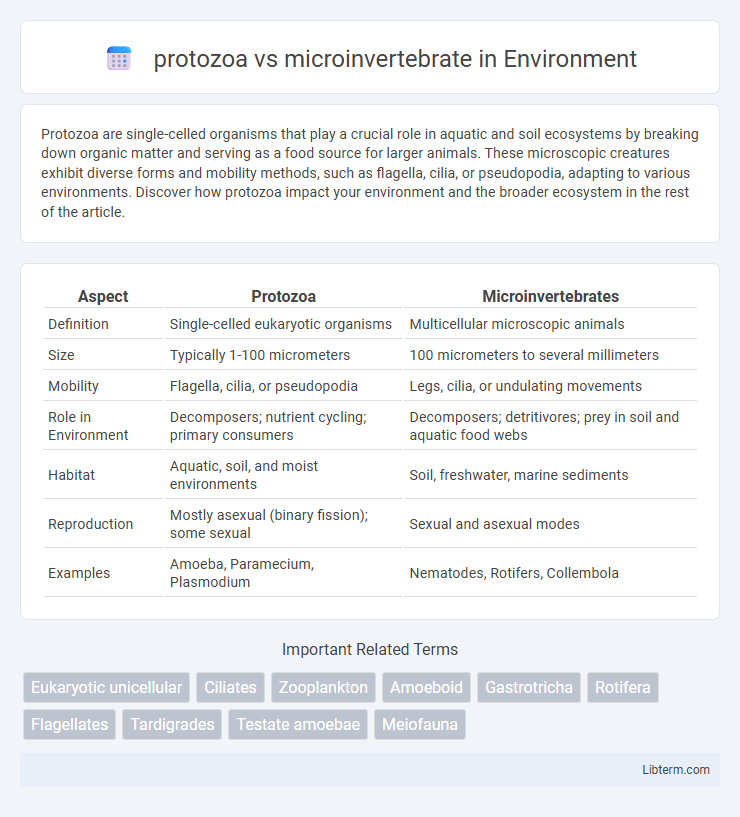Protozoa are single-celled organisms that play a crucial role in aquatic and soil ecosystems by breaking down organic matter and serving as a food source for larger animals. These microscopic creatures exhibit diverse forms and mobility methods, such as flagella, cilia, or pseudopodia, adapting to various environments. Discover how protozoa impact your environment and the broader ecosystem in the rest of the article.
Table of Comparison
| Aspect | Protozoa | Microinvertebrates |
|---|---|---|
| Definition | Single-celled eukaryotic organisms | Multicellular microscopic animals |
| Size | Typically 1-100 micrometers | 100 micrometers to several millimeters |
| Mobility | Flagella, cilia, or pseudopodia | Legs, cilia, or undulating movements |
| Role in Environment | Decomposers; nutrient cycling; primary consumers | Decomposers; detritivores; prey in soil and aquatic food webs |
| Habitat | Aquatic, soil, and moist environments | Soil, freshwater, marine sediments |
| Reproduction | Mostly asexual (binary fission); some sexual | Sexual and asexual modes |
| Examples | Amoeba, Paramecium, Plasmodium | Nematodes, Rotifers, Collembola |
Introduction to Protozoa and Microinvertebrates
Protozoa are single-celled eukaryotic organisms found in diverse aquatic and soil environments, characterized by their ability to move and feed using cilia, flagella, or pseudopodia. Microinvertebrates, including species like nematodes, rotifers, and tardigrades, are microscopic multicellular animals that play crucial roles in soil and freshwater ecosystems by contributing to decomposition and nutrient cycling. Both protozoa and microinvertebrates serve as vital components of food webs, influencing microbial community dynamics and ecosystem stability.
Defining Protozoa: Key Characteristics
Protozoa are single-celled eukaryotic organisms characterized by their heterotrophic nutrition, motility through cilia, flagella, or pseudopodia, and their ability to reproduce asexually or sexually. Unlike microinvertebrates, which are multicellular and have complex organ systems, protozoa exhibit simpler cellular structures and are often found in aquatic and soil environments as integral components of microbial food webs. Key characteristics distinguishing protozoa include their size, typically ranging from 1 to 100 micrometers, flexible cell membranes, and their role in nutrient cycling and as primary consumers in ecosystems.
What Are Microinvertebrates?
Microinvertebrates are tiny animals typically measuring less than 1 millimeter, including species such as nematodes, rotifers, and tardigrades, which play essential roles in soil and aquatic ecosystems. Unlike protozoa, which are single-celled eukaryotes often found in water and soil environments, microinvertebrates are multicellular organisms with more complex structures. These organisms contribute significantly to nutrient cycling, decomposition, and serve as key indicators of environmental health.
Taxonomy and Classification Differences
Protozoa are unicellular eukaryotes classified within the kingdom Protista, primarily grouped based on their locomotion methods, such as flagella, cilia, or pseudopodia. Microinvertebrates include small multicellular animals from various phyla, including Arthropoda, Nematoda, and Annelida, distinguished by their complex body structures and organ systems. Taxonomically, protozoa represent a diverse collection of single-celled organisms lacking true tissues, whereas microinvertebrates comprise multiple distinct taxonomic groups with differentiated tissues and organs.
Morphological Variations: Protozoa vs. Microinvertebrates
Protozoa exhibit simple, unicellular morphology with diverse shapes such as amoeboid, flagellated, or ciliated forms, allowing high adaptability in aquatic and soil environments. In contrast, microinvertebrates possess complex multicellular body plans with segmented structures, appendages, and specialized organs for locomotion and feeding. These fundamental morphological differences reflect protozoa's microscopic single-cell functionality versus microinvertebrates' more intricate multicellular anatomy and ecological roles.
Life Cycles and Reproductive Strategies
Protozoa typically reproduce through rapid asexual methods such as binary fission, with some species capable of sexual reproduction to increase genetic diversity, resulting in relatively short and simple life cycles. Microinvertebrates, including small aquatic animals like nematodes and rotifers, exhibit more complex life cycles with distinct developmental stages and diverse reproductive strategies ranging from parthenogenesis to sexual reproduction. These variations allow protozoa to swiftly colonize environments, while microinvertebrates balance survival and adaptation through more elaborate reproductive adaptations.
Habitats and Ecological Niches
Protozoa primarily inhabit aquatic environments, including freshwater, marine, and moist soil, thriving in microhabitats such as sediments and biofilms where they play crucial roles in nutrient cycling and microbial food webs. Microinvertebrates occupy diverse habitats ranging from leaf litter and soil to freshwater and marine sediments, acting as key decomposers and prey for higher trophic levels in their ecological niches. Both groups contribute significantly to ecosystem functioning through their interactions in complex habitats, influencing nutrient dynamics and energy flow.
Role in the Food Web and Ecosystem Functions
Protozoa primarily act as microbial predators by consuming bacteria and small organic particles, driving nutrient cycling and energy flow in aquatic and soil ecosystems. Microinvertebrates, such as nematodes and crustaceans, function as secondary consumers and decomposers, breaking down organic matter and feeding on protozoa, fungi, and detritus, thereby enhancing nutrient mineralization. Both groups are crucial for maintaining ecosystem stability by linking microbial activity to higher trophic levels and supporting biodiversity through their varied ecological roles.
Applications in Research and Environmental Monitoring
Protozoa serve as bioindicators in water quality assessments due to their sensitivity to pollutants, providing early warnings of ecosystem health changes. Microinvertebrates, including aquatic insects and crustaceans, are integral to freshwater biomonitoring programs because their presence and diversity reflect long-term environmental conditions. Both groups contribute to ecological research by offering insights into trophic dynamics and nutrient cycling within aquatic habitats.
Comparative Summary: Protozoa vs. Microinvertebrates
Protozoa are unicellular, microscopic organisms primarily found in aquatic environments and soil, playing essential roles in nutrient cycling and as primary consumers in food webs. Microinvertebrates, such as nematodes and tardigrades, are multicellular, microscopic animals that contribute to soil health and decomposition by feeding on organic matter and microorganisms. While protozoa exhibit simple cellular structures and rapid reproduction, microinvertebrates possess more complex anatomies and diverse ecological functions within microhabitats.
protozoa Infographic

 libterm.com
libterm.com